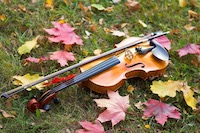Monday, November 5, 2018
 Hello and happy fall! Daylight savings is around the corner, leaves are changing color and there's a little chill in the air each morning. It's a beautiful time of year, but does your instrument think so?
Hello and happy fall! Daylight savings is around the corner, leaves are changing color and there's a little chill in the air each morning. It's a beautiful time of year, but does your instrument think so?
As the air cools and the humidity starts to drop string instruments begin to move about a little. They aren't going to jump out of their cases or start wiggling in your hands, although that would be a pretty good Halloween trick. The movements they make are very subtle, but can be noticeable. Violin family instruments are made primarily of wood, which means they are hydroscopic. The various components of an instrument act like a sponge to the moisture in the air.
During spring and summer, as the humidity rises they absorb moisture and swell. This results in both structural and tonal differences. Wood that is more saturated with moisture gets larger and softer. In the warmer months, the upper block of the instrument expands and pushes the neck and fingerboard down, which makes the strings higher. The top and back of the instrument also absorb moisture, which not only makes them swell, but also makes them softer. This in turn can affect the tone of the instrument, making it less focused by muting the higher overtones. If your instrument gets too wet, your tone can get muddy.
What happens during the fall and winter months? As the air dries out, your instrument will start to move in the opposite direction. As the moisture leaves the wood, everything contracts and becomes more brittle. This is why cracks and open seams tend to form in the cooler months. The physical manifestation, other than cracks and seams, is that as the upper block contracts the neck and fingerboard moves up. This causes the strings to be closer to the fingerboard. Tonally, the higher overtones that may have been muted in the warmer months can come back, sometimes very noticeably. An overly-dry instrument can sound harsh and thin.
What can we do to find the happy middle ground? This time of year, it is important to make sure your instrument stays comfortably humidified. When it's in the case, use an in-case humidifier. When it's out in the open, try to use room humidifiers. Halloween is fun. But there's no reason your instrument should get scared!
 | Karl Franks has over 25 years of experience as a professional luthier including a decade overseeing a prominent Boston violin workshop. He is classically trained and is an expert in repair and restoration, setups, and bow work. |

PMC Drum Head Garage Sale

